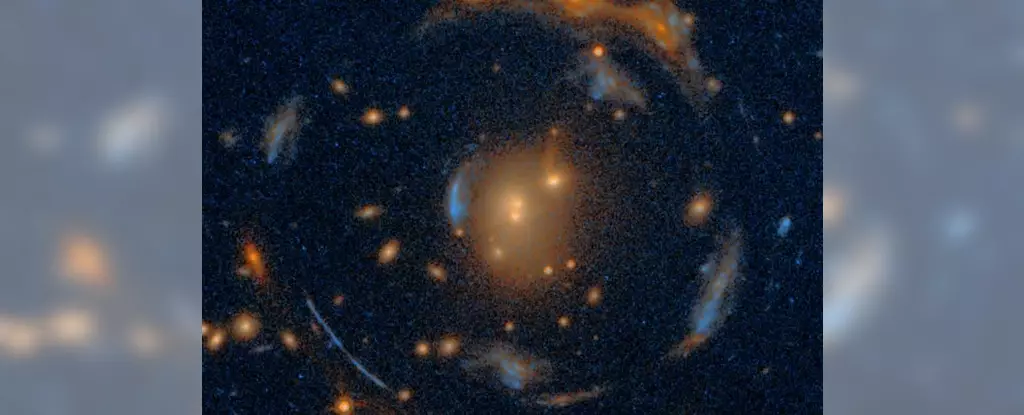Gravitational lensing, a phenomenon that takes advantage of the compelling insights of Einstein’s theory of general relativity, functions much like a cosmic magnifying glass. This intricate interaction with gravity acts as a multifaceted lens, bending light from distant celestial bodies and warping their images. This unique visual distortion not only piques our curiosity but also offers astronomers invaluable information about the distribution of matter in the cosmos. Among the most recent discoveries is the intriguing “Carousel Lens,” an exceptional cosmic arrangement of galaxies unveiled by astronomers using the Hubble Space Telescope.
This rare celestial alignment captures the attention of scientists with an intriguing configuration comprising seven distant galaxies, whose images have been drastically warped by the gravitational influence of an intervening galaxy cluster. According to David Schlegel, a senior scientist at Berkeley Lab, such a remarkable alignment is an exceptional find, akin to discovering “eight needles inside a haystack.” The term “Carousel Lens” stems from the mesmerizing, circular arrangement in which these galaxies form concentric patterns around the foreground galaxy cluster, unfurling a grand visual spectacle reminiscent of a carnival carousel.
The discovery of the Carousel Lens dates back to its identification in data collected from the Dark Energy Survey several years ago. Now, with astronomers focusing their efforts on this captivating object, the opportunity to measure the mass of the intervening galaxy cluster and understand the effects that gravitational lensing has on the images of the distant galaxies is within reach. The gravitational lens configuration encompasses a foreground galaxy cluster situated approximately 5 billion light-years away from Earth, designated as DESI-090.9854-35.9683.
Within this luminous cosmic tapestry, the seven background galaxies are positioned at staggering distances ranging from about 7.6 billion to 12 billion light-years from our own planet. This substantial separation is essential for understanding the gravitational forces at play—which manifest as multiple distorted images of each of these distant celestial objects. Notably, one of the galaxies in this configuration, identified as 4a, 4b, 4c, and 4d, emerges as a nearly perfect “Einstein Cross,” a perfect demonstration of mass distribution in gravitational lensing.
The Carousel Lens represents a profound example of a “strong lens,” illustrating the complexities of galaxy clustering. As Xiaoshang Huang of the Berkeley team notes, the alignment embodies an astonishing collection of seven galaxies in five distinct groupings, poised nearly perfectly behind the foreground cluster. The cosmological significance of this configuration extends beyond mere aesthetics; it is a promising avenue for probing dark matter and dark energy’s enigmatic characteristics—a pursuit that remains pivotal to our understanding of the Universe.
The team’s research, recently published in a scientific paper, delves deep into modeling the Carousel Lens, elucidating its intricate structure. This thorough study aims to untangle the various lensing configurations present in the data, characterizing the diverse geometric phenomena produced—ranging from arcs and diamond shapes to the Einstein Ring and instances of double lensing.
An intriguing facet of this research is the disparity in distances between the gravitational lens and the galaxies it affects. Such variations present rich opportunities for cosmological exploration, particularly through spectral studies aimed at deciphering matter distribution within the lensing cluster. By examining at least seven lensed sources, researchers can glean insights into both dark and baryonic matter within these complex systems.
Cosmic History in Focus
One particular source within the Carousel Lens, identified as source 7, is of special interest due to its potential connection to high-redshift quiescent galaxies. Observed as a “red” entity in infrared spectra, this source could exemplify what is known as “early galaxy quenching,” a process whereby star formation within a galaxy comes to a halt, prompting a notable change in its evolution. This phenomenon often occurs as a result of interactions involving supermassive black holes or as a consequence of galaxy mergers—a common occurrence throughout the primeval Universe.
The Carousel Lens, alongside similar gravitational lenses, serves as a vital conduit for studying the epochs of cosmic history. They provide a glimpse into the transformative events that shaped galaxies, eventually leading us to the richly diverse cosmos we observe today. As researchers continue to analyze and understand the intricacies of the Carousel Lens, they inch closer to unraveling the mysteries enshrined deep within the fabric of the Universe. The marriage of advanced observational technology and innovative modeling amplifies our capability to uncover the universe’s secrets, reinforcing the symbiotic relationship between curiosity and discovery in the realm of astrophysics.

